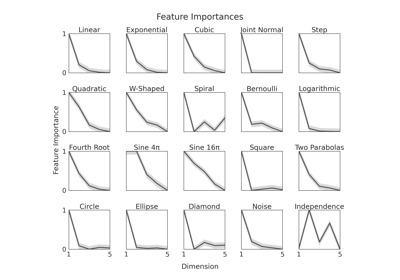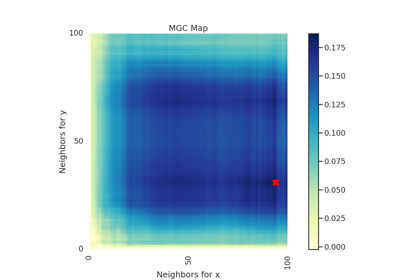KMERF¶
-
class
hyppo.independence.KMERF(forest='regressor', ntrees=500, **kwargs)¶ Kernel Mean Embedding Random Forest (KMERF) test statistic and p-value.
The KMERF test statistic is a kernel method for calculating independence by using a random forest induced similarity matrix as an input, and has been shown to have especially high gains in finite sample testing power in high dimensional settings 1.
- Parameters
forest (
"regressor","classifier", default:"regressor") -- Type of forest used when running the independence test. If the y input intestis categorial, use the "classifier" keyword.ntrees (
int, default:500) -- The number of trees used in the random forest.compute_distance (
str,callable, orNone, default:"euclidean") -- A function that computes the distance among the samples for y. Valid strings forcompute_distanceare, as defined insklearn.metrics.pairwise_distances,From scikit-learn: [
"euclidean","cityblock","cosine","l1","l2","manhattan"] See the documentation forscipy.spatial.distancefor details on these metrics.From scipy.spatial.distance: [
"braycurtis","canberra","chebyshev","correlation","dice","hamming","jaccard","kulsinski","mahalanobis","minkowski","rogerstanimoto","russellrao","seuclidean","sokalmichener","sokalsneath","sqeuclidean","yule"] See the documentation forscipy.spatial.distancefor details on these metrics.
Set to
Noneor"precomputed"ifyis already a distance matrices. To call a custom function, either create the distance matrix before-hand or create a function of the formmetric(x, **kwargs)wherexis the data matrix for which pairwise distances are calculated and**kwargsare extra arguements to send to your custom function.distance_kwargs (
dict) -- Arbitrary keyword arguments forcompute_distance.**kwargs -- Additional arguments used for the forest (see
sklearn.ensemble.RandomForestClassifierorsklearn.ensemble.RandomForestRegressor)
Notes
Note
This algorithm is currently under review at a peer-reviewed conference.
A description of KMERF in greater detail can be found in 1. It is computed using the following steps:
Let \(x\) and \(y\) be \((n, p)\) and \((n, 1)\) samples of random variables \(X\) and \(Y\).
Run random forest with \(m\) trees. Independent bootstrap samples of size \(n_{b} \leq n\) are drawn to build a tree each time; each tree structure within the forest is denoted as \(\phi_w \in \mathbf{P}\), \(w \in \{ 1, \ldots, m \}\); \(\phi_w(x_i)\) denotes the partition assigned to \(x_i\).
Calculate the proximity kernel:
\[\mathbf{K}^{\mathbf{x}}_{ij} = \frac{1}{m} \sum_{w = 1}^{m} I(\phi_w(x_i) = \phi_w(x_j))\]where \(I(\cdot)\) is the indicator function for how often two observations lie in the same partition.
Compute the induced kernel correlation: Let
\[\begin{split}\mathbf{L}^{\mathbf{x}}_{ij}= \begin{cases} \mathbf{K}^{\mathbf{x}}_{ij} - \frac{1}{n-2} \sum_{t=1}^{n} \mathbf{K}^{\mathbf{x}}_{it} - \frac{1}{n-2} \sum_{s=1}^{n} \mathbf{K}^{\mathbf{x}}_{sj} + \frac{1}{(n-1)(n-2)} \sum_{s,t=1}^{n} \mathbf{K}^{\mathbf{x}}_{st} & \mbox{when} \ i \neq j \\ 0 & \mbox{ otherwise} \end{cases}\end{split}\]Then let \(\mathbf{K}^{\mathbf{y}}\) be the Euclidean distance induced kernel, and similarly compute \(\mathbf{L}^{\mathbf{y}}\) from \(\mathbf{K}^{\mathbf{y}}\). The unbiased kernel correlation equals
\[\mathrm{KMERF}_n(\mathbf{x}, \mathbf{y}) = \frac{1}{n(n-3)} \mathrm{tr} \left( \mathbf{L}^{\mathbf{x}} \mathbf{L}^{\mathbf{y}} \right)\]
The p-value returned is calculated using a permutation test using
hyppo.tools.perm_test.References
- 1(1,2)
Cencheng Shen, Sambit Panda, and Joshua T. Vogelstein. Learning Interpretable Characteristic Kernels via Decision Forests. arXiv:1812.00029 [cs, stat], September 2020. arXiv:1812.00029.
Methods Summary
|
Helper function that calculates the KMERF test statistic. |
|
Calculates the KMERF test statistic and p-value. |
-
KMERF.statistic(x, y)¶ Helper function that calculates the KMERF test statistic.
-
KMERF.test(x, y, reps=1000, workers=1, auto=True, random_state=None)¶ Calculates the KMERF test statistic and p-value.
- Parameters
x,y (
ndarrayoffloat) -- Input data matrices.xandymust have the same number of samples. That is, the shapes must be(n, p)and(n, 1)where n is the number of samples and p is the number of dimensions.reps (
int, default:1000) -- The number of replications used to estimate the null distribution when using the permutation test used to calculate the p-value.workers (
int, default:1) -- The number of cores to parallelize the p-value computation over. Supply-1to use all cores available to the Process.auto (
bool, default:True) -- Automatically uses fast approximation when n and size of array is greater than 20. IfTrue, and sample size is greater than 20, thenhyppo.tools.chi2_approxwill be run. Parametersrepsandworkersare irrelevant in this case. Otherwise,hyppo.tools.perm_testwill be run.
- Returns
Examples
>>> import numpy as np >>> from hyppo.independence import KMERF >>> x = np.arange(100) >>> y = x >>> '%.1f, %.2f' % KMERF().test(x, y)[:1] '1.0, 0.001'

